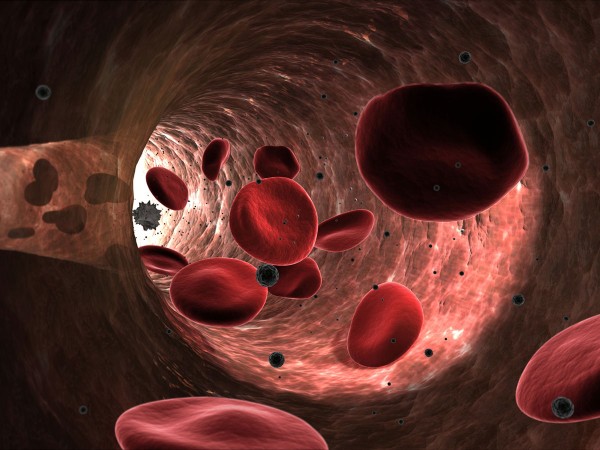博文
红细胞被改造成药物载体
||
红细胞数量占机体细胞的25%,其主要功能是运输氧气和二氧化碳,其他的功能似乎并不多,这些细胞没有细胞核,无法进行复制,一旦产生后,经过4个月就会死亡。过去也有过用红细胞携带药物的类似思路,是将药物设法放到红细胞内,让红细胞作为运输药物的载体。但是过去这种药物躲藏在细胞内的方法对发挥效应等方面也存在缺陷,于是科学家最近突发奇想,将红细胞适当改造,改造的技术是采用基因工程方法让红细胞表面表达可以粘附特定药物分子的蛋白质。由于成熟红细胞没有细胞核,无法继续表达蛋白质,因此必须在红细胞没有成熟前表达出需要的蛋白质。实验就是按照这样的设计进行,初步研究结果表明,这种方法具有可行性,表达的蛋白可以按照要求吸附相应分子,给动物注射这种细胞后,红细胞可以在体内存活28天,药物可以被红细胞携带,动物也没有健康问题。这一研究已经在线发表在PNAS上。
这个思路非常值得学习,或者血液中其他细胞甚至更小的结构,例如微核、血小板、白细胞、脂蛋白等也可以被改造成具有不同功能的药物运输设备。利用身体自身的武器,作为治疗疾病的手段,总是最聪明的作法。生物医学研究太多问题需要探索,太多好点子等我们去尝试。

Asred blood cells zip through vessels, they deliver oxygen to nearly every nookand cranny of your body. But oxygen isn’t all they can tote around. Byengineering red blood cells to have “sticky” proteins on their surface, a teamof researchers has given the cells the ability to carry anything from drugs totreat immune disorders or cancer to radioactive molecules used in imaging ofblood vessels.
“This is really a greatidea, and a very novel approach,” says biochemist Vladimir Muzykantov of theUniversity of Pennsylvania, who was not involved in the new work.
Redblood cells account for a quarter of all human cells in the body and survivefor an average of 4 months. Their ubiquity and long life makes them an idealvehicle to carry therapeutics throughout the body, says immunologist HiddePloegh of the Massachusetts Institute of Technology in Cambridge. Previously,researchers have loaded red blood cells with drugs by pushing the molecules throughthe cell’s membrane into its interior, but the process weakens the cell, andthe molecules are released only when the cell reaches its final destination.
Ploeghand his colleagues instead wanted to attach molecules to the outside of redblood cells. Because red blood cells don’t have nuclei—and therefore lackgenetic material that can be tweaked to make new proteins—the researchersturned to erythroblasts, precursors to red blood cells that still contain DNA.The scientists added to erythroblasts altered versions of genes that are knownto encode proteins found on the surface of red blood cells. The introduced genesequences, though, had modifications so that the erythroblasts produced surfaceproteins with an extra marker that’s recognized by a protein called sortase.
Thoseengineered proteins remained as the erythroblasts matured into red blood cells.When the researchers added sortase to the matured cell mixtures, the proteinsnipped off the ends of any proteins the researchers had genetically modified,leaving “sticky” trailer hitches for cargo. Any molecule with a correspondingsortase tag would then bind to the surface protein on the red blood cell. Toshow that the hitch would work, Ploegh’s team attached the vitamin biotin tored blood cells and infused them into mice. The biotin-toting cells survivedfor at least 28 days in circulation and did not harm the mice, they reportonline today in the Proceedings of the National Academy of Sciences.
Ploeghenvisions the technique being used to create a new type of personalized therapyin the future—your own cells could be isolated, used to create stem cells thatdifferentiate into erythroblasts, genetically modified to carry a molecule, andreinjected into your body. Any molecule that needs to be spread through thecirculatory system could be the cargo. By the time the cells have matured backinto red blood cells, they will have lost their DNA, eliminating the risk ofongoing mutations or the spread of genetic materials. “The payloads you caninstall are limitless,” Ploegh says. “But a lot of the applications are still,for now, hypothetical.”
Muzykantov,who has developed other approaches for using red blood cells as molecularvehicles, says the significance of the new method “exceeds just drug delivery.”It could be used to track red blood cells to diagnose blood diseases, spreadimaging agents throughout the body to visualize atherosclerotic plaques orblocked arteries, or neutralize the immune system before transplants byblocking antibodies that enter the bloodstream.
“But there are lots ofquestions to address in animal models,” he adds. “I would love to see ademonstration that a real drug binds to a red blood cell using this approachand is still effective.”
http://www.pnas.org/content/early/2014/06/25/1409861111
https://blog.sciencenet.cn/blog-41174-808334.html
上一篇:器官移植领域的又一次革命
下一篇:小保方将参加STAP细胞验证工作